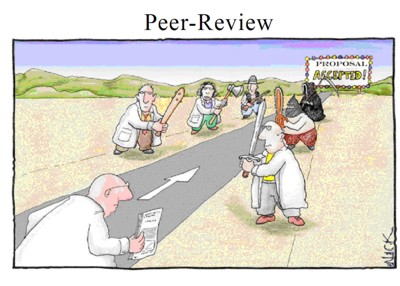

Most granting agencies have peer review committees to evaluate each application. The peer review committee of the Canadian Institutes of Health Research (formerly MRC) is typical
A CIHR committee consists of about a dozen scientists.
In the 15 min the following (a few problematic grants can take 45 min):
1. The two internal referees (two members out of the twelve members who are most knowledgeable in your field) announce their rating (e.g. 4.2 out of a five point scale). If both internals give a rating of 2.5 or less (and there is no objection from the rest of the committee), the grant is 'triaged' and no discussion takes place.
2. The two internal referees give just enough summary to introduce the grant and review the application and track record: innovations, strengths, weakness. (Note that the two internals will probably be the only two committee members that will have read you entire grant. If you want them to be your advocates to the others you have to give them ammunition; something concrete. You have to convince them of your excellence. They have to understand and explain the importance of your work to the rest of the committee. They are probably not in your field. Write your grant with this in mind.)
3. The reviews of the external referees are presented. (These are experts in your field. They are not likely to miss obvious flaws. The referee's report consists of a) an assessment of your track record; your productivity and its significance, b) a synopsis of your application and c) an assessment of the scientific merit of your proposal; its strengths & weaknesses. Write your application in a such a way that each of these elements, hopefully with the exception of weaknesses, can be readily extracted, summarized, and relayed accurately to the rest of the committee.)
4. The application is discussed by the committee with focus on differences of view between referees and factors important in the rating.
5. A summary of the preceding discussions is made by the Chair or the Scientific Officer.
6. The internal referees reach a consensus on a mark (consistent with previous awards?). If the internal reviewers can't reach consensus (this happens rarely) the two ratings are simply averaged.
7. Individual members vote on the rating (This must be within +/-0.5 of the rating proposed by the internal referees. The take home message here is that the two internal referees have a lot of clout. Find out who they are. Keep this fact in mind when you write the grant. Select the committee to which you submit your grant carefully.)
8. Consideration of Budget (Note that the budget should, in theory, have little effect in the rating but not vice versa). Overlap with other funding or ethical concerns are flagged.
9. Term of grant (usually 3 or 5 years) .
10. The Scientific Officer writes a report summarizing what the committee thought the
grant's strengths and weaknesses are. This report is eventually sent to the
applicant along with the internal reviewers' reports and the external reviewers' reports.
Read this report carefully even if the grant was awarded.
This sequence is important to keep in mind when writing your grant.
![]()
Copyright © 1995 |
Created 28 Sept 1995 |